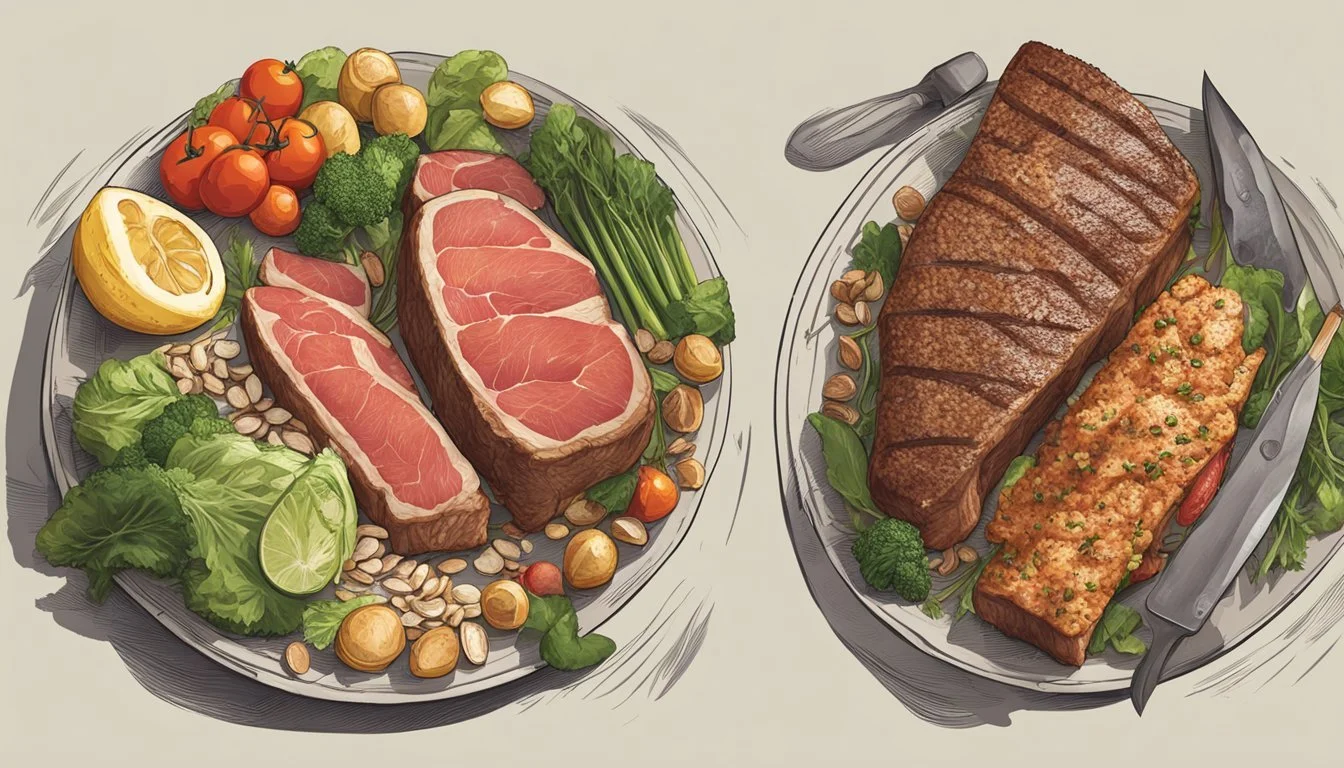Carnivore Diet vs. The Nordic Diet
Comparative Health Impacts and Sustainable Practices
The Carnivore Diet and the Nordic Diet embody two contrasting nutritional philosophies, with devotees of each claiming numerous health benefits. The Carnivore Diet is a regimen that includes exclusively animal products, proposing that a meat-centric approach to eating is more aligned with human evolution and can lead to improved health outcomes. This diet minimizes carbohydrate intake by eliminating plant-based foods and is often highlighted for its simplicity and purported effects on weight loss and inflammatory conditions.
Contrastingly, the Nordic Diet shares similarities with the well-known Mediterranean Diet, emphasizing whole foods that are local and seasonal. It is characterized by a high intake of fruits, especially berries, whole grains such as rye, barley, and oats, fish, legumes, and low-fat dairy. The liberal use of canola oil as a primary fat source distinguishes it from the Mediterranean Diet's preference for olive oil. Advocates of the Nordic Diet suggest it not only supports health and weight management but also sustainability and environmental protection, given its focus on locally sourced and seasonal produce.
These dietary frameworks thus present a stark choice: a return to a primal, meat-based diet versus a progressive, sustainable approach that champions the regional and seasonal availability of foods. Each diet's impact on health continues to be a subject for debate and research, encouraging individuals to consider their personal health goals, ethical beliefs, and lifestyle preferences when choosing between the two.
Understanding the Carnivore Diet
The Carnivore Diet focuses on consuming animal products exclusively and eliminates plant-based foods. This dietary approach has gained attention for its potential health impacts and the simplicity of its food sources.
Historical Evolution of the Carnivore Diet
The Carnivore Diet is not a contemporary invention but rather has historical roots dating back to when early humans consumed primarily meat due to hunting being a major food source. In modern times, it reemerged as an extreme form of a low-carb, high-fat diet, emphasizing that human beings can thrive on animal products alone.
Primary Components and Food Sources
Meat: Beef, pork, lamb, venison
Poultry: Chicken, turkey, duck
Fish: Salmon, mackerel, sardines
Eggs: Chicken, duck
Dairy: Butter, cheese (for some adherents)
Fats: Animal fats like lard and tallow
Saturated Fat Intake: Due to its reliance on animal products, the diet is typically high in saturated fats.
Health Impacts of an All-Meat Diet
Consuming an all-meat diet can have various health implications. Proponents argue it may lead to weight loss, improved mood, and simpler digestion. Critics raise concerns over potential risks such as increased cholesterol levels and a lack of fiber leading to digestive issues. Diet quality is a significant consideration with the absence of fruits, vegetables, and whole grains.
The Carnivore Diet in Different Locations
In the USA, the Carnivore Diet has seen a upsurge within low-carb and keto communities. Meanwhile, in regions like Africa, where traditional diets may naturally be high in meat consumption, it bears similarities to indigenous food systems, although the modern Carnivore Diet is much more restrictive in scope. Location often dictates the types of animal products available and shapes how the diet is practiced.
Exploring the Nordic Diet
The Nordic Diet emphasizes whole, locally-sourced foods, with a strong focus on balance and sustainability, impacting both physical and mental health.
Origins and Cultural Significance
The Nordic Diet has its roots in the culinary traditions of countries such as Denmark, Finland, Norway, Iceland, and Sweden. It reflects the sustainable food-related practices of these nations, making use of seasonal and local produce. The diet has gained attention for its potential health benefits and cultural significance, as it promotes an environmentally friendly way of eating that is closely tied to the northern European way of life.
Key Elements of the Nordic Diet
At its core, the Nordic Diet consists of:
Whole grains: rye, barley, and oats.
Proteins: predominantly seafood (rich in omega-3 fatty acids) and lean meats.
Fats: sourced from canola oil, which is locally produced and offers a healthier fat profile.
Dairy: moderate amounts of cheese and yogurt.
These elements contribute to a dietary pattern that is high in fiber, healthy fats, and lean proteins, while being lower in sugars and processed foods.
Balanced Diet: Understanding the Role of Fruits and Vegetables
Fruits and vegetables play a central role in the Nordic Diet, with a special emphasis on:
Berries: such as lingonberries, bilberries, and cloudberries, which are high in antioxidants.
Root vegetables: like carrots and beets, regularly used for their nutritional content and adaptability in various dishes.
Cruciferous vegetables: including cabbages and swede, valued for their fiber and vitamin content.
This focus ensures a high intake of vitamins, minerals, and fiber, promoting a balanced diet.
The Nordic Diet and Mental Health Benefits
Research has indicated that the Nordic Diet may offer:
Cognitive benefits: due to the high content of omega-3 fatty acids from fish.
Mood stabilization: potentially linked to the diet’s whole food approach and balanced nutrient intake.
This holistic approach to eating emphasizes not just physical health through a balanced diet, but also the mental well-being that comes with nutritious food consumption.
Carnivore vs. Nordic: Nutritional Showdown
The Carnivore and Nordic diets represent vastly different approaches to nutrition. As we pit them against each other in various arenas, key differences emerge in their macronutrient profiles, sustainability impacts, and effects on mental health and well-being.
Macronutrient Profiles and Health Outcomes
The Carnivore diet is heavily skewed towards protein and fats, with virtually no carbohydrates. It primarily consists of meat, fish, and animal products, excluding all plant-based foods. Proponents claim benefits such as weight loss and reduced inflammation; however, the lack of fiber and certain vitamins can be detrimental over time.
The Nordic diet emphasizes balance and variety, including carbohydrates from whole grains, lean proteins from fish and legumes, and healthy fats from nuts and seeds. It's associated with lower risks of cardiovascular disease and type 2 diabetes, largely due to its diversity in nutrient-rich foods that contribute to overall diet quality.
Sustainability and Environmental Considerations
Carnivore Diet:
Pros: Can support local meat production and nose-to-tail consumption.
Cons: High environmental impact due to methane emissions from livestock and resource-intensive meat production.
Nordic Diet:
Pros: Encourages consumption of in-season and local produce, reducing transportation emissions.
Cons: Seafood reliance can impact marine ecosystems if not sustainably sourced.
In terms of food systems, the Nordic diet is generally considered more sustainable and environmentally friendly compared to the meat-intensive Carnivore diet.
Impact on Mental Health and Well-being
Carnivore Diet:
Possible Benefits: May improve symptoms in individuals sensitive to plant antinutrients.
Concerns: Restrictive nature can lead to social isolation during meals and lack of essential nutrients could impact cognitive function over time.
Nordic Diet:
Benefits: High in omega-3 fatty acids and fiber, shown to support brain health.
Additional Perks: The diet's variety and emphasis on whole foods is linked to improved mental well-being and lower stress levels.
The choice between these diets should consider individual health needs and how each diet's approach to nutrition aligns with one's lifestyle and long-term health goals.
Impact of Global Events on Diet Trends
Significant global events, such as the COVID-19 pandemic, have altered dietary patterns and preferences across different cultures and continents. They highlight the impact of external pressures on individual and collective food choices.
The Effect of COVID-19 on Dietary Choices
The COVID-19 pandemic has had a palpable influence on dietary choices. In the wake of health concerns, many individuals have become more attuned to the nutritional value of their diets. The Carnivore Diet, often perceived as extreme due to its exclusive focus on animal products, gained attention for its alleged immune-boosting potential. Conversely, the Nordic Diet, with its emphasis on whole grains, fruits, and vegetables sourced from sustainable and local origins, was bolstered by the pandemic-driven focus on health and immunity.
Food Supply Chains and Pandemic Challenges
During the pandemic, food supply chains encountered significant disruptions. The sudden onset of lockdowns led to a decline in the availability of certain foods, forcing people to adapt their diets. The Carnivore Diet faced challenges due to the dependency on consistent meat supply, whereas the Nordic Diet's reliance on a wider variety of foods, including those sourced locally, cushioned it against some of these shocks.
Impact of Supply Chain Disruptions
Shortages of meat products
Increased demand for local produce
Lockdowns: Bulk Buying and Food Skills
Lockdown measures resulted in a surge of bulk buying and panic buying episodes. Consumers, fearing shortages, piled up goods, including non-perishables and freezer-friendly items. As a result, individuals with a preference for the Carnivore Diet may have found it challenging to obtain the necessary quantities of fresh meat, while those adhering to the Nordic Diet capitalized on stocking up on grains and frozen goods.
Consumer Buying Patterns
High demand for freezable meat products
Rise in bulk purchases of grains and vegetables
Lockdowns also provided an opportunity for many to enhance their food skills. With restaurants closed and more time spent at home, cooking became a necessity and a hobby. This led to a renewed interest in the preparation of wholesome meals, aligning well with the principles of the Nordic Diet and challenging the simplicity of the Carnivore Diet.
Growth of Food Skills
Increased home cooking practices
Exploration of diverse recipes and ingredients
Consumer Behavior and Diet Adoption
Understanding consumer behavior is fundamental to the adoption of any diet. It comprises the preferences of consumers, how they manage and plan their diets, and the impact of policies and interventions on diet choices.
Survey-Based Insights on Diet Preferences
Surveys play a crucial role in capturing consumer preferences between the Carnivore and the Nordic diets. Studies indicate a dichotomy of diet adoption, with some consumers favoring the Carnivore diet for its simplicity and potential health benefits, while others prefer the Nordic diet for its sustainability and balance. Consumer sentiments often reflect broader dietary movements and health trends, influencing individual choices and societal norms.
Diet Management: Planning and Preparation
The Carnivore diet, with its meat-centric approach, can be logistically straightforward but might demand more from planning ahead to ensure nutritional adequacy. Conversely, the Nordic diet involves diverse food items—including fruits, vegetables, and seafood—requiring consumers to be more conscientious about meal planning and preparation. Effective diet management often leads to higher adherence rates and successful integration into daily life.
Interventions and Policy Implications
Interventions and policy changes can substantially influence consumer diets. For the Nordic diet, governmental support in the form of subsidies for local produce can encourage consumer adoption. In the case of the Carnivore diet, interventions are less policy-driven and more community-supported, relying on shared experiences and anecdotal successes to proliferate diet adoption. Both diets respond differently to these approaches, illustrating the complexity of dietary adherence within different socio-economic contexts.
Cross-Continental Perspective
In this section, we explore the contrasting dietary habits rooted in the disparate environments and cultural histories of various continents, illustrating how geography and isolation have influenced food practices.
Comparing Food Practices Across Continents
Food practices vary significantly across continents due to differences in climate, availability of food resources, and cultural evolution. For instance, The Nordic Diet is rich in whole grains like rye, barley, and oats, along with a variety of berries and fish, reflecting the abundance of these foods in Northern Europe's environment. In contrast, The Carnivore Diet, which is a recent dietary trend more common in the USA, emphasizes the consumption of animal products exclusively, a dietary practice that was probably out of necessity in prehistoric times when plant-based foods were less accessible during harsh winters or in arid regions.
New Zealand, with its extensive coastlines, has a diet rich in seafood similarly to the Nordic Diet.
In Africa, the food practices are diverse, with some regions consuming a plant-based diet due to the rich availability of fruits and vegetables, while others have meat-centric diets, particularly in pastoral societies.
These dietary practices have evolved over generations, adapting to the resources available and the demands of the local environment.
Isolation and Cross-Continental Food Practices
Isolation, whether geographical or cultural, has played a pivotal role in defining the food practices on different continents. Geographical isolation, as seen in New Zealand and Nordic countries, often results in a diet adapted to local resources, with a heavy reliance on seafood and seasonal produce. Cultural isolation can perpetuate traditional food practices even in the face of globalization, as seen in some African tribes and indigenous communities in the USA.
Nordic countries have developed their diet around the available local resources, with a focus on sustainability and environmental protection.
Conversely, the USA has seen a mix of diets due to its melting pot culture, with the Carnivore Diet being one of the many dietary choices that have surfaced due to individual preferences rather than environmental necessity.
In all these examples, isolation shapes food practices, which are a blend of historical availability and modern choices.
Conclusion
When comparing the Carnivore and Nordic diets, one must consider personal health goals, dietary preferences, and sustainable practices. The Carnivore diet, focusing exclusively on animal products, particularly meat from ruminant animals, salt, and water, targets those seeking to reduce carbohydrate intake and may be explored by individuals aiming for specific health outcomes.
On the other hand, the Nordic diet emphasizes a balanced approach with heavy reliance on whole foods, including whole grains such as rye and oats, fruits like berries, and locally sourced seasonal produce. It mirrors the health-promoting aspects of the Mediterranean diet, with both sharing a foundation in plant-based nutrition and sustainability.
Nutritional Balance:
Carnivore Diet: May provide high protein and fat, low in carbohydrates.
Nordic Diet: Offers a balance of macronutrients, including beneficial fibers and complex carbs.
Sustainability:
Carnivore Diet: Raises concerns due to high environmental impact of meat production.
Nordic Diet: Prioritizes local, seasonal produce, with a lesser environmental footprint.
In conclusion, the Nordic diet might suit those looking for a flexible and environmentally conscious dietary pattern that aligns with broad health recommendations. It's essential to note that individual dietary needs vary greatly, and one should consider personal health conditions and seek professional advice when choosing a diet.








